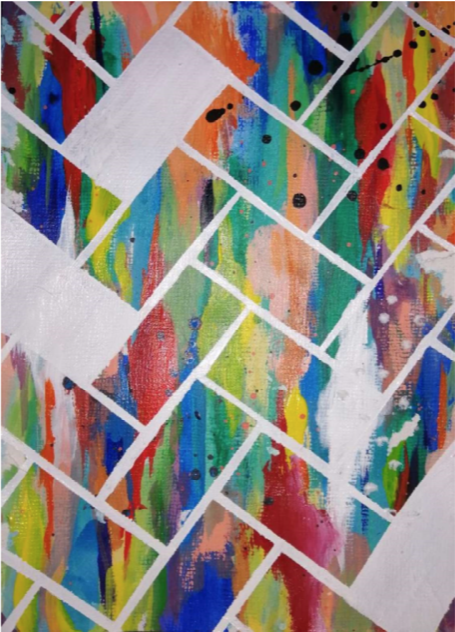Curiosity
I guess you could see my painting like that, where each colourful rectangle is another piece of knowledge gained throughout the consultation, the white patches blanks where information is still missing, all fitting together to show ‘the full picture’. However, I prefer a different analogy. The idea of a patient being a puzzle suggests that they present to us as bits of puzzle pieces for us to problem solve and fit together, when in reality most patients already know their story and we just have to ask the right questions to see them. My painting is instead trying to show how when you first meet a patient, it is almost as if they have a big brick wall around them; the wall represents our initial lack of understanding of the patient as we don’t yet know anything about them. They are already a fully formed puzzle, just on the other side of a wall that we cannot yet see through. The more you talk to the patient – the more you gather about their history, perspective, lifestyle – the more you can start to remove these bricks of ignorance, look through the wall and see the person waiting behind it.
In my painting, by removing the white ‘bricks’ you reveal the colourful background that represents everything the patient is and stands for. The better we can see them as a whole, the better care we can provide, tailored and personalised to their specific needs and views. The wall could also represent barriers that some patients put up themselves. With authentic compassion, curiosity, and empathy, we can start to help patients open up, as they begin to trust us more with what they originally didn’t feel comfortable revealing. If they feel they can confide in us, the more information we have to work with and the better relationship we have, the easier it is to help them.
Effective Consulting Creative Prize-winner
Year Two, 2020

This piece really struck me because you can read into it in such a myriad ways with its dual metaphorical meaning.
I really like the notion that people are like a puzzle (or a set of building blocks.) Whilst the idea is logical, it has been portrayed in such a beautiful and abstract way, representing how complicated the multi-step process of breaking down one’s personal history truly is. The stark colour contrasting the white sharp brick outlines make the concept unmissable.
The different colours, each representing a different story, emotion or experience all merging together to create an individual’s identity. No experience in life is distinct and this painting displays that perfectly, with streaks of colour crossing over each other in all directions.
This is such a powerful piece, largely due to its simplicity.
I love the deeper interpretation of how the white ’bricks’ in the painting represent the initial lack of understanding when the patient first presents, and that it is the doctor’s duty to uncover the bricks and reveal the beautiful, colourful and complicated story underneath. I think it is very easy in consultations to only remove a certain number of bricks, for example due to time constraints or a difficulty in establishing rapport. However, this piece highlights the importance of whole person-centred care, as each colourful brick is so unique, all must be seen for the picture to be complete.
No two bricks are the same, which further highlights the differences in backgrounds and stories which make up an individual’s identity.
This piece has allowed me to reflect on how vital curiosity is in fully understanding the individual presenting to you, as a person not just as a patient.
This piece initially caught my attention due to the striking use of colour. However on reading the artist’s comment the statement on building an image and fitting puzzle pieces together to see the entire image of a person – an image that previously existed but was unknown to the doctor, and unearthed slowly like peering through a fog which clears with conversation, really resonated with me. Removing the white surface layer to see the vibrant colours underneath is a beautiful metaphor. Strokes which overlap with each other to make a whole only obstructed by a colourless layer of unfamiliarity.
The title ‘curiosity’ strikes me even before the vibrant art piece. In my understanding, it is the fundamental driving force behind both science and human nature.
Secondly, the metaphorical representation of ‘removing bricks’ is a really affirmative expression of effective consulting.
The randomly mixed colour shows the uniqueness of each individual, emphasising the importance of holding curiosity to truly ‘see’ the patient, like ‘I SEE YOU’ in movie Avatar. We should work tend to remove all the bricks/walls to fully or maximising the understanding of patient’s needs and wants, for the dedicated patient centred care. I use ‘maximising’ because I interpret the remaining white bricks as the parts of patient life they kept as private and reserved, as well as the remaining white lines between the reviewed bricks. This is also served as a reminder during consultations or every human interactions for respect and safeguarding individuals’ privacy and dignity.